Joshua Kennerly Speer
1794-1858
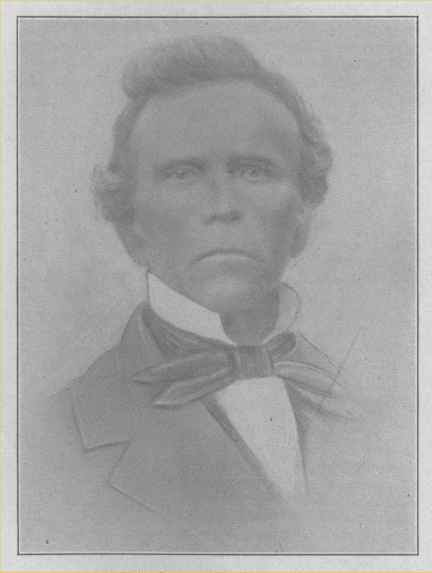
![]()
Biographical Sketch Of The Life Of J. K. Speer
Very few realize the hardships that were endured by preachers of the gospel a hundred years ago. There were two very formidable enemies, the world and religious denominations. These enemies are found today in many communities, but they are not so prejudiced and bitter in their persecutions as they were in the earlier days of the Restoration Movement. It was unpopular to proclaim "the ancient order." Oftentimes the one who proclaimed the gospel had to suffer persecution. Those who preached the gospel at that time came out of some well-established denomination. When one came out of a denomination and began preaching the gospel, he lost the friendship of all his acquaintances and incurred the enmity of the denomination whence he came.
Joshua Kennerly Speer was born in 1794, in Yadkin County, North Carolina. He was the son of Aaron Speer; his mother's name was "Elizabeth." He was reared in the Baptist faith. His parents were what they then called "Old Baptists," or Primitive Baptists. Joshua K. Speer accepted the teaching of his father, but could not understand the theories concerning predestination and election. He searched for light from all whom he thought were able to give him help. He held long and interested interviews with the prominent Baptist preachers of his faith. They tried to satisfy his mind, but were unable to do so. He doubted the whole system of the Baptist faith. Some of his preachers told him that his "doubts" were strong evidence that he was one of the elect. However, this did not remove the difficulty from his mind.
At the age of twenty-four he came to Tennessee and located in Williamson County not far from Franklin. This put him in new environments. He thought that be might find comfort and further instruction with respect to his religious life. By nature he was pious and humble. He wanted to do the will of God, but did not know how to begin it. He had never read the Bible. It did not occur to him to read the Bible for instruction. He began reading the New Testament, and soon he saw the light. He was baptized by Elder J. J. Trott. However, he identified himself with the Baptist Church of his community. It did not occur to him that he could be a Christian, without belonging to some of the denominations. He knew that they were wrong, that they taught much error, but he attributed this to the frailty of man.
On the fourth Lord's Day in November, 1823, he began to preach. He was identified with the Baptists that time. He was not trying to preach what the Baptists believed, but what little he knew of the Bible. He wanted to honor God and teach his truth, but he had learned very little of it at that time. He became a reader of the Christian Baptist, published by Alexander Campbell, and this led him to preach with more clearness the truth as revealed in the New Testament. It was difficult for him to banish from his thoughts the confusion of religious error that he had learned. He continued to preach, and was among the first in the State of Tennessee to come from the Baptists and preach "the ancient order of things." He set his heart to the task of teaching his neighbors and all who would listen to him the will of God. He was a successful preacher and had a wonderful influence over his hearers. He entered the evangelistic field and preached in Northern Alabama and Middle Tennessee wherever opportunity was offered him.
He was positive in nature and preached the gospel in a direct way. There was no misunderstanding him. He had but little education from books, but he became quite familiar with the teachings of the Bible and had the gift of expressing himself with clearness and force. He had sympathy for those in error, and, with his power of presenting the truth with clearness and his power of exhortation, he won many to Christ. In 1848 we find him teaching clearly the duty of members of the church. He wrote to the editor of the Christian Magazine and said: "For three months I have been trying to 'bring about a better state of things in the churches where I have labored, by teaching the disciples what the Scriptures, demand them to do and what they forbid their doing, as members of Christ's body." He further says: "As the course most likely to insure success in this, I have laid great stress on personal and family culture. I am perfectly convinced, that, if a member of the, church will not try to add to 'his faith all that is commanded (see 2 Pet. 1: 5-7), he should be removed from the community. Again, if a member who is at the head of the family will not read (if he can read) to, and offer prayer to God in, his family, he should be excluded." This shows that Brother Speer saw the need of teaching the word of God in the family.
In 1850 we find him preaching at Cathey's Creek, Dunlap, Liberty, and Mount Horeb. In giving a report of his work for 1849, he gives the number of additions to these churches, which amount is above three hundred. He held a meeting at Totty's Bend and baptized eighteen in July of that year. In August of the same year he held a meeting at Lynnville, Tenn., and baptized twenty-nine. He preached a week at Weakley's Creek and baptized fifteen. He held a meeting at Lasea in 1849 and baptized fifty. In 1850 we find him doing evangelistic work in Giles and Lawrence counties. In these counties he established many congregations. We find him also preaching in Wayne, Lewis, Maury, Hickman, and Lincoln counties. He established churches in all of these counties that year. In 1.852 we find a record of his work published in the Christian Magazine. In his report he says: "I bad the good fortune to plant a church at Williamsport, Maury County, Tennessee, last year [1851], numbering thirty-eight members. Several have been added to this congregation this year [1852]." There are very few congregations in Maury County that have not felt the influence of Brother Speer.
In 1855 we find him living in Rutherford County. He held a meeting for Rock Springs Church, in that county, beginning on July 13, 1855, and continuing one week, in which there were forty additions to the church. In making his report to the Gospel Advocate he says "Let us thank God and take courage." He preached monthly for the Rock Springs Church during the year 1855, and there were fifty-three additions to the church that year. On December 27, 1855, he reported to the Gospel Advocate that he had just closed a meeting at Brawley's Fork (old Brother Calvin Curlee's earthly home) with seventeen additions. He also reported that he had fifteen additions at Cripple Creek, in Cannon County, and fifteen at Millersburg, Rutherford County. He closes his report to the Gospel Advocate as follows: "As ever, your brother in the best of all labors on earth, J. K. Speer."
In 1856 he visited his old home in Yadkin County, North Carolina. He bad a brother living there at Yadkin Institute. He preached there and baptized fourteen and planted a church there. He says that he preached "three times in the meetinghouse in Rockford, and three times in the courthouse in Yadkinville, to very large congregations who seemed to be anxious to learn the gospel plan of salvation more perfectly. Never did I see a people more ripe for reformation than they are at this time in North Carolina. I believe we ought to send one or more to preach the gospel there." This report was made to the Gospel Advocate in 1856. His meeting at Yadkin Institute was held in the early spring of that year. Again we find him visiting Yadkin Institute in September of the same year. In making his report of this visit to the Gospel Advocate , he says: "I am happy to say that I found the disciples here 'walking in truth.' They have met every Lord's Day since they first became a congregation last spring. I have added nine to their number since my arrival." A later report shows that nineteen were added to the church and that he preached at five other places in the State. He reported that he had preached at Dobson, Surry County, North Carolina, and found there two ministers---one a Baptist, the other a Methodist---"both of high standing in their respective churches, and of fair abilities both natural and acquired. After hearing me three times the Baptist minister most freely gave up his humanisms for the truth, and after hearing four more discourses the Methodist made the good confession and was immersed in the name of Jesus Christ for the remission of sins; with these I gained fourteen others, thus planting a church in Dobson of sixteen members, with two of as good preachers as are to be found in that region. Thus you see I gained thirty-five in all."
We find Joshua K. Speer in 1857 living at Lavergne, Tenn., and a member of the board of trustees of Franklin College. This shows that he was in high standing and in great favor with Tolbert Fanning. He was interested in the education of the young people of his country. He was especially interested in preparing young men to preach the gospel. In giving his report for the year 1857 in the Gospel Advocate, we find him at McMinnville, Tenn., in a week's meeting, in which there were twenty additions to the church. That year he preached at Lynnville six days, with seven additions. He reports holding a meeting at New Hermon, where he labored with Brother David Lipscomb in a meeting and baptized nine. He was associated with Dr. T. W. Brents in a meeting at Liberty, with twenty-five additions. At Ebenezer he joined Brother D. Lipscomb and Brother Tolbert Fanning in a pleasant meeting, with twelve additions. This year he had one hundred and thirteen additions to the congregation at Rock Spring, in Rutherford County. No preacher labored more abundantly than did Brother Speer. This year he lived at New Hermon, in Bedford County, Tennessee. This congregation is one of the oldest congregations in the State.
Brother Speer died at his home at New Hermon, May 27,1858. A recent visit to his tomb in the little cemetery near the New Hermon church house revealed that, according to the record on the tombstone, he died in 1859. This is an error, evidently placed on the stone some years after his death. The Gospel Advocate, bound volume of 1858, page 256, gives a report of his death. The Millennial Harbinger of 1858, page 540, gives a brief report of his death. Both the Gospel Advocate and Millennial Harbinger of 1858 report his death. These evidently record the date of his death correctly; hence, the date on the tombstone is an error. Brother Speer was married twice and has many descendants now living.
-From Biographical Sketches Of Gospel Preachers, H. Leo Boles, Gospel Advocate Company, Nashville, Tennessee, 1932, pages 66-71
![]()
Location Of The Grave of J. K. Speer
GPS Location of the Grave
35°20'05.7"N 86°26'32.9"W
or D.d. 35.334926, -86.442484
From Fayetteville, Tennessee go east on Hwy 64 and then north on Hwy 50 toward Lynchburg. Turn left on Booneville Rd. Go through the little community of Booneville and dead end into Hwy 129W. Bear to the left and about 8/10 mile to New Herman Road on the right. Go out New Herman Road 3.1 mile and the church building will be on your right. Behind the building up to the right is the old cemetery. Speer's grave is toward the front of the cemetery on a hill. The obelisk shape can easily be seen from the Church Building.
From Lynchburg, Tennessee take Hwy 129W off of Hwy 55. Go about 4.6 miles and note a sharp turn to the right. (to the left is Booneville Rd.) Go around the bend to the right and go 8/10 mile to New Herman Road on the right. Go out New Herman Road 3.1 mile and the church building will be on your right. Behind the building up to the right is the old cemetery. Speer's grave is toward the front of the cemetery on a hill. The obelisk shape can easily be seen from the Church Building.
From Petersburg, Tennessee (Hwy 431) take Hwy 129E to Hwy 231 and turn right. Then turn back to the left where Hwy 129E continues. Go about 3 or 4 miles and turn left on New Herman Rd. Then 3.1 miles on the right.
While visiting the old church at New Herman and the grave of J. K. Speer, be sure to travel another 3.6 miles out New Herman Rd. to the grave of J.D. Floyd. He is buried in the Rose Bank Cemetery (on your right), in the community of Flat Creek. Go to the first entrance and as you enter, bear to the left, counting in about 12 rows, at the top of the first little rise. From the driveway it will be about 4 stones in where you'll see the "Floyd" stone which is about 4ft square in size.
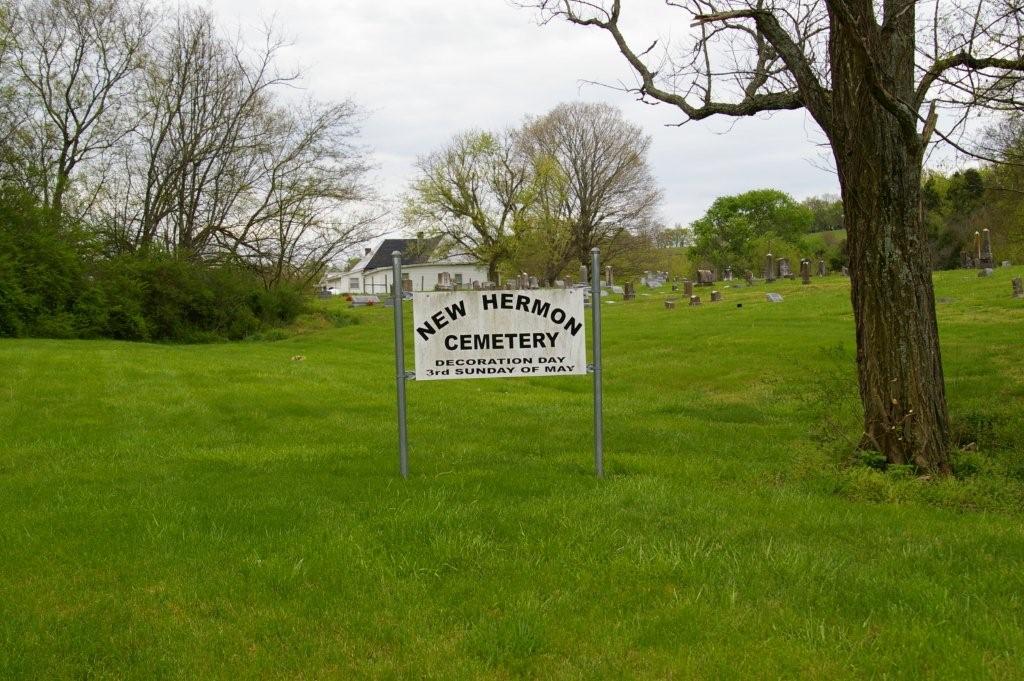
Speer Monument Past Sign And To The Right / In Front Of Cemetery
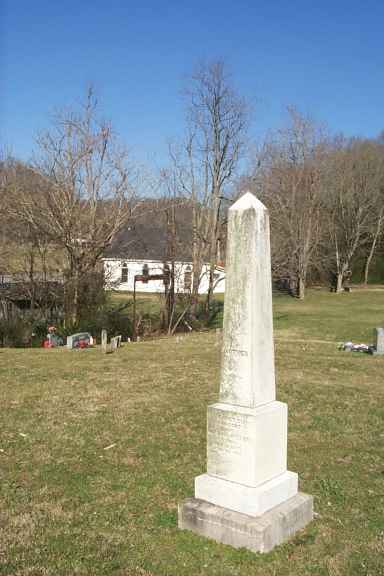
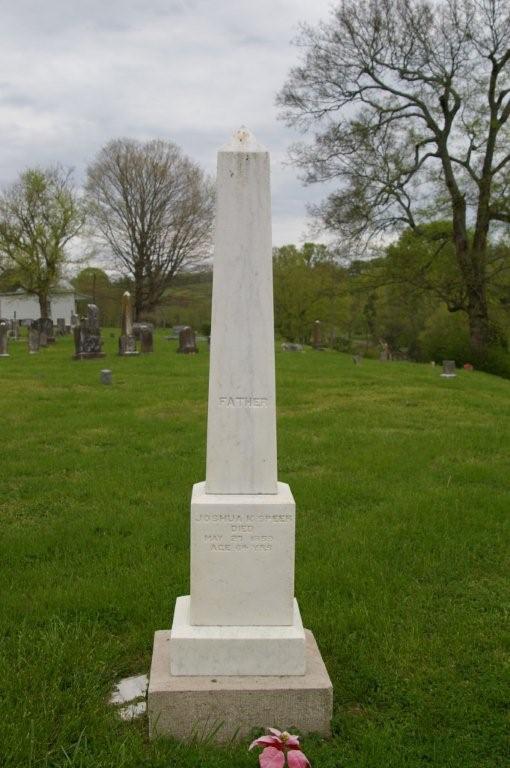
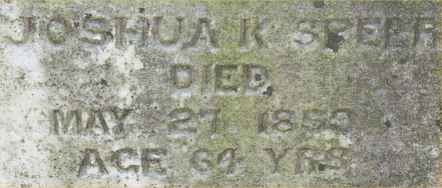
Side Piece:
Blessed Are The Dead
Which Die In The Lord
That They May Rest
From Their Labours, And
Their Works Do Follow Them
![]()